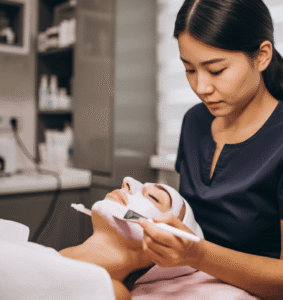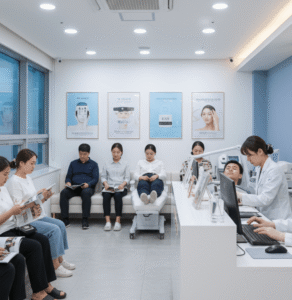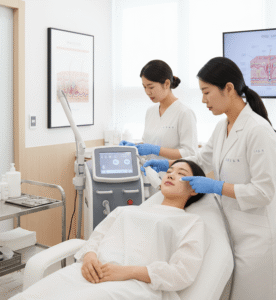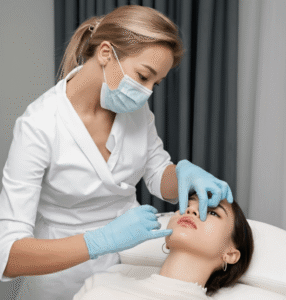What It Is
V-line jaw reduction, also known as mandibular contouring surgery, is a cosmetic surgical procedure designed to create a slimmer, more oval, and youthful lower face shape. It involves reducing and reshaping the jawbone (mandible) and sometimes the chin to achieve the highly sought-after “V-line” facial contour.
This procedure is one of the most popular facial surgeries in Korea, especially among patients who feel their jawline is too wide, square, or masculine. Korean plastic surgeons are internationally renowned for their precision and artistry in jaw contouring, making Korea a global hub for this treatment.
Why It’s Done
Cosmetic Reasons:
- Creates a softer, feminine lower face profile
- Slims down a wide or square jawline
- Enhances balance between the chin, jaw, and cheekbones
- Aligns with the Korean beauty standard of a V-shaped face
Functional Reasons:
- Corrects asymmetry in the jawline
- Can be combined with corrective jaw surgery for bite alignment
Age & Lifestyle Factors:
- Most common in young to middle-aged adults
- Patients with thicker jawbones or strong masseter muscles often benefit most
- Non-smokers and healthy individuals recover faster and achieve better results
Alternatives
- Botulinum Toxin (Masseter Botox): Reduces the size of overdeveloped jaw muscles; non-surgical but temporary
- Dermal Fillers or Fat Grafting: Used to enhance chin projection or balance proportions
- Chin Surgery (Genioplasty): Often combined with V-line surgery for harmony
- Thread Lifts: Provide subtle tightening, but do not change bone structure
Preparation
Consultation:
- 3D imaging, X-rays, or CT scans to assess bone thickness and facial structure
- Discussion of expectations and surgical plan
Pre-Surgery Protocols:
- Blood tests and general health evaluation
- Stop smoking, alcohol, and blood-thinning medications several weeks before surgery
- Fasting required for 6–8 hours before general anesthesia
How It’s Done
Type of Procedure: Surgical, under general anesthesia
Duration: 2–4 hours
Procedure Steps:
- Incisions are made inside the mouth (no external scars)
- The jawbone is accessed and reshaped by trimming or shaving the mandibular angle
- The chin may also be refined (chin reduction or sliding genioplasty if needed)
- The jawline is smoothed and contoured to achieve a natural curve into a V-shape
- Incisions are closed with dissolvable stitches
Hospitalization: Typically requires 1–2 nights in the hospital for monitoring
Recovery
- First Week: Significant swelling, especially in the lower face; pain controlled with medications
- Diet: Soft or liquid foods for the first 1–2 weeks due to intraoral incisions
- Activity: Patients usually resume daily life after 2–3 weeks, though swelling may persist longer
- Restrictions: Avoid strenuous activity and chewing hard foods for 4–6 weeks
- Final Results: Fully visible after 3–6 months once swelling resolves and tissues settle
Possible Complications
- Swelling and bruising (normal in early recovery)
- Nerve injury leading to temporary or, rarely, permanent numbness in the chin or lips
- Infection at the incision site
- Asymmetry if bone removal is uneven
- Jaw weakness or functional issues if excessive bone is removed (rare with expert surgeons)
Treatment Options in Korea
Diagnosis
Korean clinics use:
- 3D CT Imaging for detailed jawbone analysis
- Computer Simulation to preview expected outcomes
- Team Consultations between plastic surgeons and maxillofacial specialists for complex cases
Medical Treatments
For patients who don’t want surgery:
- Masseter Botox injections to slim the jaw muscles
- Non-surgical contouring methods (fillers, fat grafting) to enhance proportions
Surgical or Advanced Therapies
- Standard V-Line Jaw Reduction: Jawbone angle reduction and chin contouring
- Cortical Shaving: Refinement of jawbone surface for smoother results
- Hybrid Procedures: Combined with genioplasty, zygoma reduction, or face lifts for full contouring
- Two-Jaw Surgery (Orthognathic Surgery): For patients with skeletal malocclusion
Rehabilitation and Support
- Frequent post-op monitoring to track healing progress
- Swelling management therapies such as lymphatic massage or specialized care available in many Korean clinics
- International patient services: translation, airport transfers, recovery accommodations, and long-term follow-up













